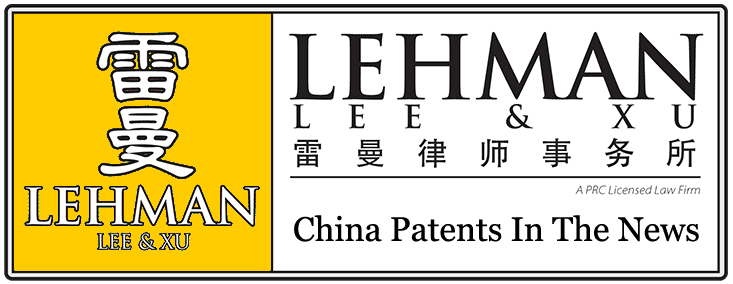
August 2013
 |
|
LEHMAN, LEE & XU China Lawyers
|
|
China Patents In The News
|
|
August 2013 |
The China Law News keeps you on top of business, economic and political events in the China. |
|
|
|
In the News |
China’s SIPO Issues FAQs Relating to Patent Law |
Aug. 16 – With the view to facilitate a better understanding of the country’s Patent Law, China’s State Intellectual Property Office (SIPO) has issued a set of frequently asked questions regarding the types, duration and application of patents in the country. The answers provided are based on existing regulations. Detailed information can be found below. Q: Why do I need a China patent? A: If your invention has Chinese market potential and you think that other companies could make profits from your invention, you need a patent to protect your invention. In China, a patent gives individuals the right to exclude others from making their products. Also, it gives individuals the right to initiate legal action against anyone who is making or selling their inventions without permission. In addition, individuals can make money by licensing or selling their inventions to someone else. Q: How many types of industrial property rights exist in China? A: There are three kinds of industrial property rights in China, including: Patents; Trademarks; and Copyrights. More specifically, patents are composed of: Patents for inventions; Patents for utility models; and Patents for designs. Q: What are the differences between the three types of patents? A: China’s Patent Law has defined “inventions” “utility models” and “designs” as follows: Invention refers to any new technical solution relating to a product, a process or the improvement thereof; Utility model refers to any new technical solution relating to the shape, the structure, or their combination, of a product, which is fit for practical use; and Design refers to any new design of the shape, the pattern or their combination, or the combination of the color with shape or pattern, of a product, which creates an aesthetic feeling and is fit for industrial application. Q: What is the duration of a Chinese patent? Q: What language shall be used for a patent application in China? Q: What kinds of inventions cannot be patented in China? A: According to China’s Patent Law, the following items cannot be patented in the country: Scientific discoveries; Rules and methods for mental activities; Methods for the diagnosis or for the treatment of diseases; Animal and plant varieties; Substances obtained by means of nuclear transformation; and Designs that are mainly used for marking the pattern, color or combination of both pattern and color. Q: What documents are needed for patent applications in China? Q: What are the conditions for granting patent rights? A: Any invention or utility model for which patent right may be granted must possess the following three characters: Novelty Inventiveness Practical applicability Any design for which patent right may be granted must not be identical with and similar to any design which, before the date of filing, has been publicly disclosed in publications in the country or abroad, or has been publicly used in the country, and must not be in conflict with any prior right of any other person. Q: What applicants can do if their patent applications have been rejected? A: Where an applicant has different ideas with the decision rendered by the Patent Administration Department under the State Council, the applicant may, within three months from the date of receipt of the notification, request the Patent Reexamination Board to make a re-examination. The Patent Reexamination Board shall, after re-examination, make a decision and notify the applicant. However, if the applicant is not satisfied with the decision rendered by the Patent Reexamination Board, the applicant may, within three months from the date of receipt of the notification, institute legal proceedings in the people’s court. http://www.china-briefing.com/news/2013/08/16/chinas-sipo-issues-faqs-relating-to-patent-law.html |
|
|
|
|